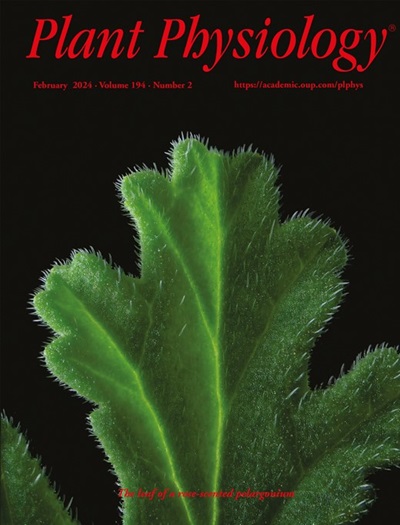Tomato CONSTANS-Like1 promotes anthocyanin biosynthesis under short day and suboptimal low temperature.
IF 6.5
1区 生物学
Q1 PLANT SCIENCES
引用次数: 0
Abstract
Plant growth and development are precisely controlled by light and temperature during their life span. However, the mechanism by which photoperiod and seasonal changes influence the physiological response of day-neutral plants, such as tomato (Solanum lycopersicum), remains unclear. Here, we found that the tomato CONSTANS (CO) close homolog, CONSTANS-Like1 (SlCOL1), does not affect the flowering of tomato under either long-day (LD) or short-day (SD) conditions. However, CRISPR/Cas9-mediated editing of SlCOL1 showed a much lower anthocyanin accumulation in mutant than in wild-type plants, especially under SD at suboptimal low-temperature conditions. SlCOL1 directly activated the Hoffman's Anthocyanin 1 (SlAN1) promoter and interacted with SlAN1 to promote anthocyanin biosynthesis under SD. The cold-induced up-regulation of SlCOL1 further promoted anthocyanin accumulation and enhanced Reactive oxygen species (ROS) scavenging under SD at low-temperature conditions. These results reveal that the SlCOL1-SlAN1 module collaboratively regulates anthocyanin accumulation under SD and cold conditions, which could help tomato counteract the cold autumn/winter season in nature.番茄CONSTANS-Like1在短日照和次优低温条件下促进花青素的生物合成。
植物的生长发育在其一生中受到光和温度的精确控制。然而,光周期和季节变化影响昼中性植物(如番茄)生理反应的机制尚不清楚。本研究发现,无论在长日照(LD)还是短日照(SD)条件下,番茄CONSTANS (CO)同源基因CONSTANS- like1 (SlCOL1)都不影响番茄的开花。然而,CRISPR/ cas9介导的SlCOL1编辑显示,突变体中的花青素积累量远低于野生型植物,特别是在次理想低温条件下的SD下。SlCOL1直接激活Hoffman's Anthocyanin 1 (SlAN1)启动子,与SlAN1相互作用,促进SD下花青素的生物合成。低温条件下,低温诱导的SlCOL1表达上调进一步促进了花青素积累,增强了活性氧(ROS)清除能力。这些结果表明,SlCOL1-SlAN1模块协同调节低温和低温条件下的花青素积累,有助于番茄抵御自然界寒冷的秋冬季节。
本文章由计算机程序翻译,如有差异,请以英文原文为准。
求助全文
约1分钟内获得全文
求助全文
来源期刊

Plant Physiology
生物-植物科学
CiteScore
12.20
自引率
5.40%
发文量
535
审稿时长
2.3 months
期刊介绍:
Plant Physiology® is a distinguished and highly respected journal with a rich history dating back to its establishment in 1926. It stands as a leading international publication in the field of plant biology, covering a comprehensive range of topics from the molecular and structural aspects of plant life to systems biology and ecophysiology. Recognized as the most highly cited journal in plant sciences, Plant Physiology® is a testament to its commitment to excellence and the dissemination of groundbreaking research.
As the official publication of the American Society of Plant Biologists, Plant Physiology® upholds rigorous peer-review standards, ensuring that the scientific community receives the highest quality research. The journal releases 12 issues annually, providing a steady stream of new findings and insights to its readership.
 求助内容:
求助内容: 应助结果提醒方式:
应助结果提醒方式:


